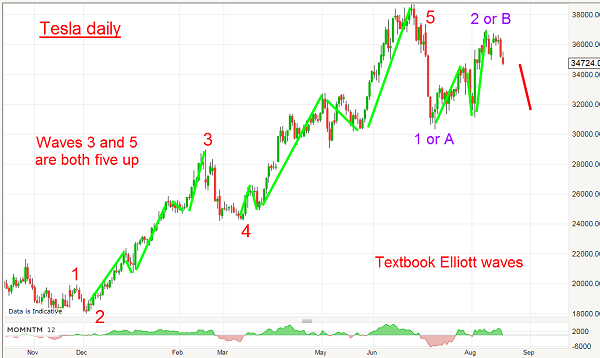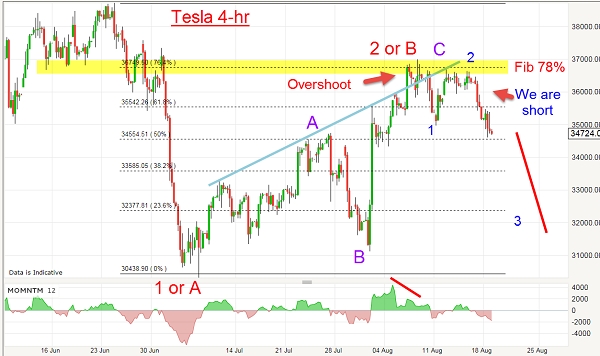Chart of the Week: Why this high-flyer has run out of gas
21st August 2017 10:55
by John Burford from interactive investor
Share on
Has Tesla reached a major top?
is a real stockmarket darling of the 21st century electric vehicle revolution.
Readers with very long memories will recall the 1920s, when electricity and its cousin electronics were sweeping all before it with such newfangled gadgets as TV, radio, the washing machine and even the vacuum cleaner that were going mainstream.
In fact, the brand name Hoover became synonymous with the latter in much the same way as Kleenex became in paper tissues.
And just as the hype for ever more optimistic targets reached its zenith, the crash of 1929 got started - and many companies in the tech sector went bankrupt.
But this time, it is the electric vehicle and self-driving future we approach. Not only that, but there is heightened interest in the flying car - a long-wished-for dream.
Reviving interest in the concept, in June a French aviator crossed the English Channel in a flying car which echoed the pioneering exploits of his compatriot Louis Bleriot as he was the first to fly the Channel in 1909 (but in a much flimsier biplane).
With today's surge in the drive to revolutionise transport, the goals are becoming ever more optimistic.
One manufacturer hopes to have a flying car in production that has a range of 500 miles and cruises at 200 mph. I wouldn't fancy trying to land on the M5 to Cornwall on a Bank Holiday Friday!
And there are even plans for commercial airliners that cruise at "hypersonic" speeds with plasma engines to get you from London and Shanghai in two hours.
In addition, the race for higher and higher speeds using revolutionary (and untested) technology is well and truly on - and that is a characteristic of an extreme in bullish sentiment.
For contrarians, this is a sure sign stocks have entered the last phase of a major bull run.
Tesla is right at the heart of this electric revolution and the mainstream media (MSM) have universally taken it as read that it will arrive with few glitches. A recent Economist article proclaimed "the death of the internal combustion engine".
That is a very bold statement and highlights the faith they have in the new technology; but it assumes an awful lot will go right and is thus complacent to an extreme - another sign a top is near.
So, yes, you can begin to junk your old smelly car and get with the programme of clean green electrical energy - or can you?
Veteran MSM-watchers know that when a big story is highlighted in the Economist after it has been in the public consciousness for a lengthy period, it usually signals the end of that trend (at least for a while). In fact, this magazine is notorious for providing timely major contrarian signals.
So, do we have a major top in Tesla as contrarily predicted by the Economist?
Here is the daily chart from last November:

Just one glance should convince that we have a textbook five-wave impulsive bull run with waves 3 and 5 containing their own fives. But in July, the shares plunged as wave 5 topped (fifth waves are ending waves). The excuse given then was the "disappointing" deliveries of their $100,000 (£77,500) cars. Hmm.
But as the shares entered chart support, they began a classic A-B-C rally as the general market sentiment improved. However, as the price rallied to important Fibonacci levels, I began to monitor this chart very carefully.
I knew that if we really did have a major high in June, this rally would make a turn below it and hopefully I could pinpoint it at one of the Fibonacci levels.
And that is precisely what occurred last week - here is the four-hour chart:

I have a terrific blue trendline across the minor highs, but in early August it pushed above the line in what I term an "overshoot" and then quickly retreated. That was my first clue a turn was at hand.
Then the rally reached the important Fibonacci 78% level, and on a strong momentum divergence - and provided another set of clues for a turn.
With the market retreating into Friday's close, I can label the small purple waves 1 and 2 in place, and the shares are in a third wave down and has hit support at the A wave high.
If my labels are correct, we are in a wave three of three - the most powerful in the book. So, has Tesla really run out of gas? The odds appear to suggest it has.
These articles are provided for information purposes only. Occasionally, an opinion about whether to buy or sell a specific investment may be provided by third parties. The content is not intended to be a personal recommendation to buy or sell any financial instrument or product, or to adopt any investment strategy as it is not provided based on an assessment of your investing knowledge and experience, your financial situation or your investment objectives. The value of your investments, and the income derived from them, may go down as well as up. You may not get back all the money that you invest. The investments referred to in this article may not be suitable for all investors, and if in doubt, an investor should seek advice from a qualified investment adviser.
Full performance can be found on the company or index summary page on the interactive investor website. Simply click on the company's or index name highlighted in the article.
Disclosure
We use a combination of fundamental and technical analysis in forming our view as to the valuation and prospects of an investment. Where relevant we have set out those particular matters we think are important in the above article, but further detail can be found here.
Please note that our article on this investment should not be considered to be a regular publication.
Details of all recommendations issued by ii during the previous 12-month period can be found here.
ii adheres to a strict code of conduct. Contributors may hold shares or have other interests in companies included in these portfolios, which could create a conflict of interests. Contributors intending to write about any financial instruments in which they have an interest are required to disclose such interest to ii and in the article itself. ii will at all times consider whether such interest impairs the objectivity of the recommendation.
In addition, individuals involved in the production of investment articles are subject to a personal account dealing restriction, which prevents them from placing a transaction in the specified instrument(s) for a period before and for five working days after such publication. This is to avoid personal interests conflicting with the interests of the recipients of those investment articles.